- NLI Research Institute >
- Economic Forecast for FY 1998 -Economy Struggles to 0.5% Growth Amid High Risk of Downturn-
Economic Forecast for FY 1998 -Economy Struggles to 0.5% Growth Amid High Risk of Downturn-
the Economic Research Dept.
Font size
- S
- M
- L
1. Domestic Economy − High Risk of Downward Spiral
(1) Present Status
New housing starts turned negative on a year-on-year basis in January 1997, while other indicators including automobile sales and large retail store sales have been declining since April 1997. The 8-trillion yen additional burden to households from the consumption tax hike and termination of special tax cuts, combined with slower growth in employment and income, are raising concerns of a prolonged consumption slump.
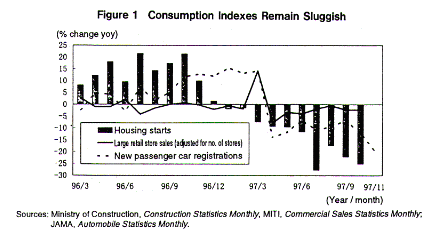
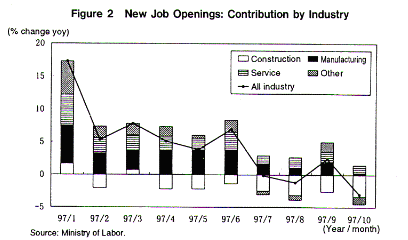
While the reactive decline in consumer spending has played out, the recovery in final demand is being delayed by the sustained impact of fiscal tightening and by stock adjustments in durable goods and residential investment.
Inventory accumulation, at first limited to automobiles and some electrical appliances such as air-conditioners, has spread to basic industries such as chemical, as inventory adjustments are intensified, production is also declining. The economy is regarded as having entered a downturn phase from the beginning of fiscal 1997.
In addition, the rekindled uncertainty in the financial system, falling stock prices, and the expanding and prolonged economic turmoil in Asia have dampened both corporate and consumer confidence and strengthened concerns that the stagnation in final demand will persist. For the time being, the economy carries a high risk of a downturn and even of a downward spiral.
(2) Assumptions and Key Points of the Forecast
1) Assumptions
| 1. | Public expenditures: In line with the fiscal structure reform law, public works spending in the general account of the fiscal 1998 budget will be reduced 7 percent. Public capital spending will decline 4 percent in nominal terms. Supplementary budgets will provide 0.5 trillion yen for disaster reconstruction, etc. during fiscal 1997. | |
| (2) | Taxation: Almost neutral change in the corporate tax (2.5-percentage-point tax rate cut, offset by an expanded taxable base), and targeted tax cuts for education, etc. | |
| (3) | Foreign exchange rate: Average exchange rate of $1 = ¥124 for the fiscal year. | |
| (4) | Official discount rate: Unchanged at 0.5 percent.
2) Factors Affecting the Economy Since the 1980s, economic recessions had been overcome through fiscal and monetary policies that increased public fixed capital formation and residential investment. However, in the present case, the new fiscal structure reforms and stock adjustments in residential investment preclude a repetition of this pattern. Thus private consumption and capital investment will need to play the lead role.
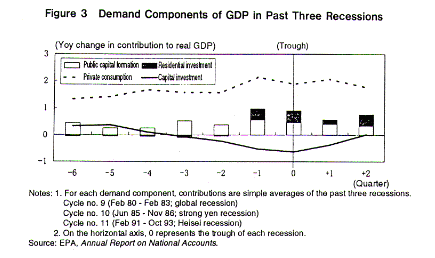
1. Sustained recovery in private sector demand Although the expected drop in consumption following the tax hikes has played out, consumption may remain sluggish. Consumer confidence has ebbed due to lower real disposable income from the increased burden on households, while employment and income growth has been sluggish and looks uncertain in the future. The weak rebound in consumer spending in the July-September 1997 quarter was not reassuring.
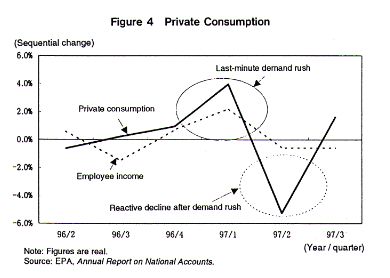
In addition, durable consumer goods and housing are still undergoing stock adjustment following the pre-tax-hike demand surge in the January-March 1997 quarter. Housing starts, which have outpaced demographic factors since fiscal 1993, are showing signs of entering a stock adjustment phase. For fiscal 1998, housing starts are predicted at approximately 1.25 million units, and should continue to decline in the future.
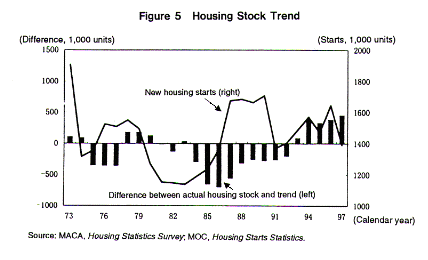
Capital investment will trend downward. Independent investment in communications-related and retail industries, which played a leading role in fiscal 1995 and 1996, has abated, while cyclical investment is peaking out, and corporate earnings are slowing down. However, aside from retail and some other industries, financing for capital investment is being limited to covering depreciation costs, and there is no sign that investment is overheating. We predict that capital investment will decline, but not plunge.
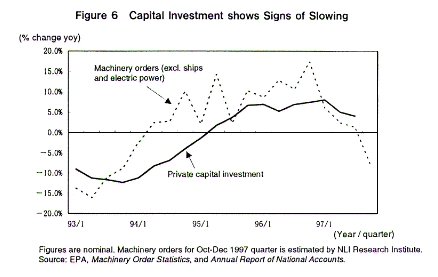
(2) Impact of fiscal tightening With its priority on fiscal reconstruction, the fiscal structural reform package aims to reduce national and local budget deficits to below 3 percent of GDP. This will introduce spending discipline in the budget formulation stage. The public works allocation in the fiscal 1998 general budget account is 7 percent less than in the initial fiscal 1997 budget, which will be a deflationary factor on the economy. The ¥1.5 trillion (nominal) reduction in fiscal 1998 will subtract 0.2 percentage point from the GDP growth rate. However, its deflationary impact will be less than the tax hikes of fiscal 1997. (3) Impact of financial system anxiety Recent failures of large financial institutions, declining stock prices, and other factors are dampening corporate and consumer confidence. This will affect consumption and capital investment, significantly impacting the real economy. The effect of financial turmoil on the real economy is also a major concern. Establishing a framework for the introduction of public funds is a key factor in stabilizing the financial system. (4) Impact of Asian turmoil Economic turmoil in Thailand and other Asian economies has spread to Korea and shows signs of expanding further and persisting. Aside from the impact on trade, econometric analysis can tell us little regarding the effect of Asia's economic problems on Japan at the present time. However, the financial impact of the growth in problem loans could further complicate matters for Japanese banks, who account for over 50 percent of Thailand's foreign loans. As for trade (only exports are considered here), Asia's economic growth is estimated to have declined 2 percent points in 1997 from 1996, and currencies fell 12 percent against the yen from January to December 1997. If such conditions persist, Asia's economic turmoil stands to reduce Japan's GDP growth rate by 0.3 percent, and the trade surplus by approximately ¥1 trillion.
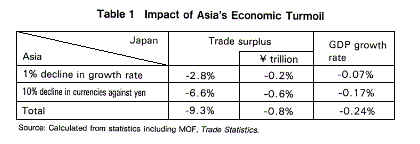
(5) Inventory adjustment in the short term Inventory adjustment, at first limited to automobiles and electrical appliances such as air-conditioners, has become full-fledged due to the prolonged slump in final demand and spread to chemical, steel and other basic industries. Inventory adjustments will continue until production bottoms out in mid fiscal 1998. (3) 1998 Forecast 1) Economic Forecast (Economy) As households adapt to their increased burdens and progress is made in stock adjustments of durable goods and inventory adjustments, the economy will stop sliding in the second half of fiscal 1998 and bottom out. The recession will continue, with the real economic growth rate of 0.5 percent, the second straight year of near-zero growth. There is serious concern that as lower earnings force companies to reduce payrolls, the unemployment rate will approach 4 percent by the end of the fiscal year. This would cause income growth to decline further, hindering consumption growth even if consumption were to recover from the reactive decline following the consumption tax hike. With independent capital investment peaking out and domestic demand weak, capital investment will post negative growth. (Public sector demand) Without large additional infusions through supplementary budgets, public works spending will decrease. (External balance) The economic crisis in Asia is limiting export growth, the contribution of external demand to economic growth will turn negative. However, since import growth is at the same time being moderated by weak domestic demand, the external surplus will remain large. The current account surplus will grow in the low 2-percent range in fiscal 1997 and 1998, possibly rekindling trade friction. Since Japan's weak economy is a negative factor to other Asian economies exporting to Japan, international pressure will mount for Japan to stimulate domestic demand. (Prices) Unlike the consumption tax hike in fiscal 1997, there are no factors that will push prices upward in fiscal 1998. Reflecting weak domestic demand and a loose supply-demand balance, prices will remain extremely stable, with the possible surfacing of deflationary concerns.
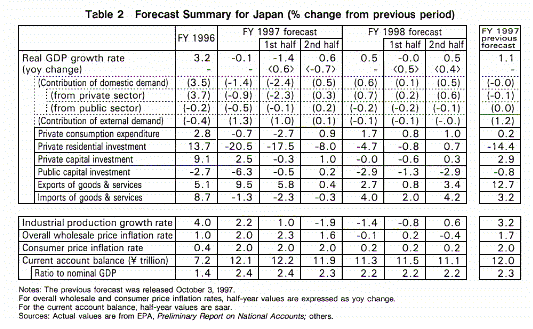
2) Forecast for Interest Rates and Exchange Rates Over two years have passed since September 1995, when the official discount rate was cut and unsecured call rate was induced downward. During this time, the long-term interest rate has declined. After bottoming out in April 1997, it surged upward briefly, but began declining again in late May and reached historical lows in Autumn due to weak consumption and residential investment, inventory adjustment pressure, and fading expectations for an economic stimulus package. We predict the ultra-low interest rate policy will be maintained in fiscal 1998 due to the weakness of the economy. The long-term interest rate will remain level, as (1) short-term rates stay unchanged and the bond market is strong, (2) the yen appreciates moderately, and (3) overseas interest rates, particularly U.S. rates, peak out.
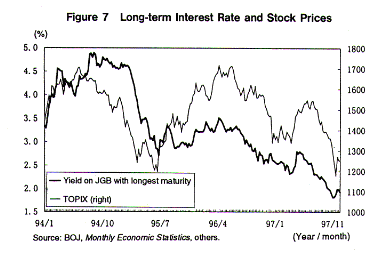
Stock prices remained steady until last summer, but then softened as U.S. stocks appeared to peak and construction companies. The worldwide decline of stock markets from late October, combined with large failures of banks and securities firms in November, prompted foreign investors to reduce their positions primarily in blue chip stocks. While the stock market has recently recovered modestly due to the expected infusion of public funds, the market remains extremely uneasy about further declines. While limited progress is expected on problems afflicting the financial system, the stock market will generally remain level or edge down. Meanwhile, there is also a sentiment that Japanese stocks are undervalued on a dollar basis. From the second half of fiscal 1997, it remains to be seen if foreign investors, who have been net sellers, will be reassured by the government's financial stabilization measures. Since late July 1997, declines in business sentiment and stock prices have helped weaken the yen. In November, the yen was hammered further by financial failures, and the exchange rate has recently been hovering at approximately ¥130. As business sentiment continues to decline, there will be strong downward pressure on the yen. From the second half of fiscal 1998, as the economy stops sliding and anxiety eases over the financial system, the yen will see a modest correction. However, with the economy remaining weak in undertone, the yen is not likely to appreciate substantially.
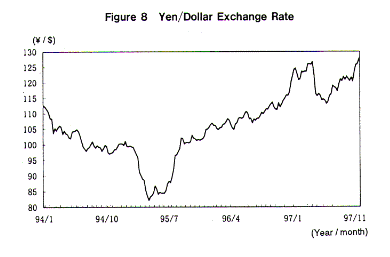
3) Policy Issues Structural reforms including deregulation and other medium to long-term issues must continue to be pursued. However, the most urgent short-term policy issues are to prevent a downward spiral and suppress growing uncertainty over the financial system. As for the problem loans of financial institutions, a framework needs to be set up immediately for the injection of public funds to bolster the financial system, which has been a major factor behind the present economic recession. Although the injection of public funds could be opposed for expanding the government deficit, the injection will not only revive the economy in fiscal 1998, but would help balance the budget more quickly in the medium to long term. We support the proposed 4 trillion yen income tax cut for fiscal 1998 − half for individuals and half for companies, and implementation of a framework for the injection of public funds.
2. Overseas
(1) North America (U.S. and Canada) and Australia Both U.S. and Canadian economies will slow down in 1998 − from 3.7 percent in 1997 to 2.2 percent in 1998 for the U.S., and from 3.6 percent to 3.4 percent for Canada. Meanwhile, Australia will remain strong, rising from 3.0 percent to 3.4 percent. 1) U.S. The present expansion of over seven years is heading toward slower growth centered around factors in the personal sector such as tight labor market and peaking out of durable goods consumption. In addition, Asia's economic problems are likely to be a drag on the economy by decreasing U.S. exports. In the first half of 1998, the economy will continue a slow phase of approximately 1-2 percent growth. The main factors behind the economy's slowdown are consumer spending centered around durable goods consumption, and sluggish exports due to Asia's economic turmoil. Sluggish demand inventory buildup is limited, a shortage of factors driving the economy other than capital investment centered around production equipment. In the second half, consumer spending will be one of the main signs of recovery. Prices will generally maintain a stable undertone. In the first half, against a backdrop of a tight labor market, inflation will be slightly higher than previous stable declining undertone, but will become stable in the second half as the economy slows down.
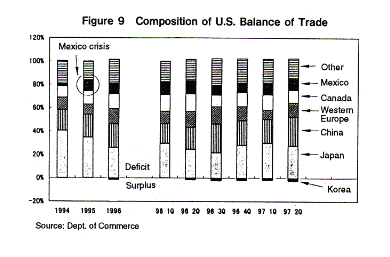
The effect of Asia's economic turmoil cannot be ignored when looking at the composition of the trade deficit. Japan and China together account for half of the U.S. trade deficit. Moreover, the present trade surplus with Korea is expected to turn into a deficit in 1998. The decline in exports to Asia and rising imports will have a negative effect on the economy. 2) Canada While the economy will slow down from 1997 to 1998, high growth will be sustained. However, with the savings rate already low, there will be a change in the usual pattern of expansion based on domestic demand. Encouraged by a low unemployment rate, high confidence among consumers and companies suggest that a sudden chilling of domestic demand is not likely, but the growth in automobile sales is expected to stop. On the other hand, residential investment is likely to continue growing. Capital investment while it peaked in 1997, will show firm growth in 1998 against a backdrop of strong investment intentions. High growth will be sustained by a virtuous cycle in which demand stimulates investment, productivity rises, and income growth spurs further demand. Prices will be stable. 3) Australia The economy has been in recovery since bottoming out in late 1996. While the slowdown of Asian economies has weakened external demand, the sustained recovery in domestic demand will lead to 3.0 percent in 1997 followed by 3.4 percent in 1998. Prices will maintain a stable trend.
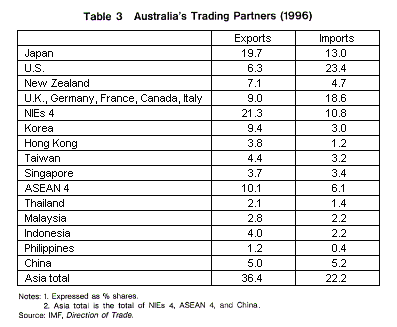
(2) Europe (U.K. and Germany) 1) Approximately 2% Growth in the U.K. and Germany The U.K. economy's growth rate is predicted to slow down from 3.6 percent in 1997 to 2.2 percent in 1998. In 1997, consumption overheated slightly due to employment and income growth, combined with the one-time income from the conversion of housing loan companies. However, as the effect of the temporary income effect fades and interest rates rise, the economy will slow down centered around consumption. The BOE raised the policy rate to 7.25 percent in November 1997. Due to a slight increase in the inflation rate, another rate hike is predicted in the first half of 1998. Germany's growth rate is predicted to edge up from 2.4 percent in 1997 to 2.5 percent in 1998. Germany is accelerating the pace of its economic expansion. In 1997, the economic expansion was centered around external demand against the backdrop of a weak DM, while domestic demand faltered from sluggish consumption as the unemployment rate hit a postwar high. In 1998, against a backdrop of a leveling off in the employment environment and high earnings in the manufacturing sector, wage increases will be relatively large, causing consumption to recover. As this occurs, the driving force of the economy will gradually shift from external demand to domestic demand. We predict that the Bundesbank, which raised the repo rate in October 1997, will implement another rate hike in the first half of 1998 due to: (1) inflationary concerns from the economic expansion, and (2) convergence of short-term interest rates with other EMU members. 2) EMU Developments After overcoming many obstacles which threatened its establishment, confidence is growing that the EMU will be successfully launched in January 1999. Eleven EU countries are predicted to participate in the EMU at the start, excluding the U.K., Sweden, Denmark (who has met economic convergence targets but is abstaining for political reasons), and Greece (who was unable to achieve economic convergence targets such as for the fiscal deficit and inflation). The Blair administration has expressed interest in EMU participation, but has stated that: (1) the U.K. will not participate from January 1999, and (2) participation is not a realistic alternative until the spring of 2002, when the term of the present legislature expires. Thus participation will be decided as public opinion allows after 2002. After the participating nations are decided in May 1998, there will be a shift to a fixed exchange rate system in January 1999, when exchange rates of member nations will be fixed. Monetary policy authority will be transferred from national central banks to the European Central Bank (ECB), and a single monetary policy will be implemented. From January 2002, when national currencies are collected and euro banknotes and coins issued, the monetary union will become complete in name and substance.
(3) Asia The currency turmoil triggered by the plunging baht continues in Asia. As financial instability expands in some countries, the outlook is becoming murkier for Asia's economies. Although Thailand (July 2) and Indonesia(August 14) shifted to floating exchange rates, Hong Kong's dollar-pegged currency has also been volatile. Hong Kong's stock market plunge in late October sent shock waves throughout global markets. In Korea, the successive failures of chaebol-affiliated companies and problems at financial institutions have cause the won to plunge. When the Korean government's plan to dispose of the bad debt did not alleviate the turmoil, the IMF stepped in and extended loans on December 3 to Korea, following Thailand and Indonesia.
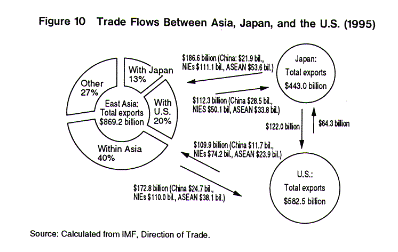
Looking at Asian economies prior to the currency crisis, Hong Kong and Taiwan have enjoyed a sustained autonomous recovery based on domestic demand since mid 1996, while exports turned upward in other countries from spring 1997. However, in Thailand, where the capital investment boom since the late 1980s ebbed just as the recent currency and financial turmoil struck, structural adjustments are inevitable in rebuilding the economy. Since Asia and Japan have strong economic and financial ties, Japan's recession and failures of financial institutions are having a major impact on the Asian economies, which are smaller and have an export-driven growth structure. Another concern is that China, whose competitiveness has declined due to the fall in Asian currencies, may devalue its own currency.
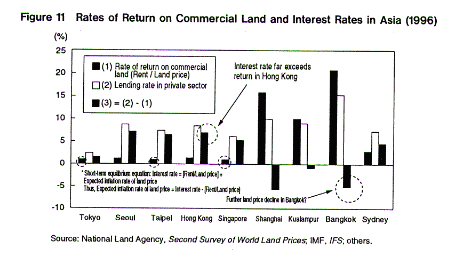
Financially, many countries are burdened by the aftereffects of the collapse of their bubble economies. The excess supply resulting from years of booming investments has resulted in high vacancy rates, and the outlook of real estate markets is bleak. Financial institutions that extended massive loans to the real estate industry are also burdened with nonperforming loans, and in Thailand 58 of 91 finance companies have stopped doing business, and of these 56 companies have closed down. In the future, to prevent financial institutions from sharply curtailing credit extension and thereby hindering the real economy, monetary authorities must take immediate measures as necessary including the supply of liquidity, and implement thoroughgoing reform to rebuild the financial system. As evident from the above, the environment surrounding Asia's economies is worsening. However, most reactions thus far have tended to be excessively pessimistic. The basic conditions underlying Asia's economic development have not changed−high savings rates, good quality of labor, and technology transfer from abroad. In the long term, Asia is expected to post high growth rates centered around the ASEAN countries, who still have much catching up to do.
|
the Economic Research Dept.
Research field

















